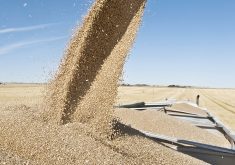Farmers will be able to get faster cash for their feed barley because of a fundamentally altered Canadian Wheat Board contracting system.
But don’t expect to see the same changes for other board grains.
The CWB will divide the crop year into two for feed barley, with one pool ending Jan. 31 and a final payment most likely in March, said the board Aug. 9.
Producers will no longer sign series A, B and C contracts, but will sign guaranteed delivery contracts for either or both of the pool periods. The board may limit the amount that farmers can sign up.
Read Also

Soybean market still figuring out implications of China-U.S. pact
Soybean futures had a muted reaction to the U.S. trade deal with China as the market tries to figure out the nuances of the deal.
It may also buy feed barley on the cash market through elevators when it needs more.
CWB spokesperson Louise Waldman said the board hopes the new system will remove some of the price insecurity from the board’s feed barley program.
“The two pools (structure) allows you to send a very accurate price signal to producers,” said Waldman.
Alberta Agriculture market analyst Charlie Pearson agreed.
“If you shorten up the pool periods, the board should be more accurate on their Pool Return Outlooks,” said Pearson.
“They’ll provide better signals and I think farmers will be able to use that to make a better decision.”
The new contracting system is not a sign of things to come in other board grains, Waldman said.
“Feed barley is different from the other pools.”
Better comparison
The domestic feed barley market competes with offshore board customers for supply, and this new system should give feed barley growers a better sense of the true value of the international market, Waldman said. That way farmers can better compare the domestic and offshore markets.
Guaranteed delivery contracts are not new. The board used them last year to get 800,000 tonnes of feed barley, which was more than 95 percent of the feed barley it handled.
Pearson said the board will probably attract little feed barley this year because the domestic price is better than the oversupplied world market.
Pearson said this system should get more money quickly into farmers’ hands, but it could go even further.
“It’s a step in the right direction but it’s still not an open market.”















